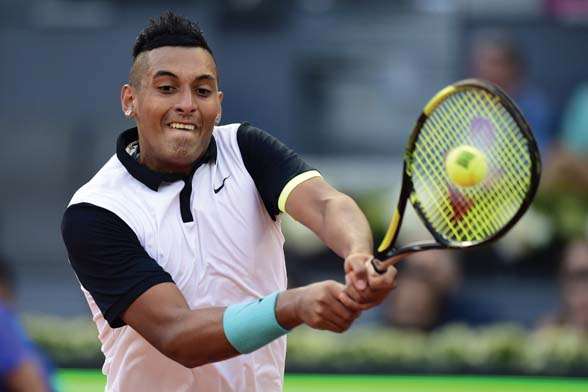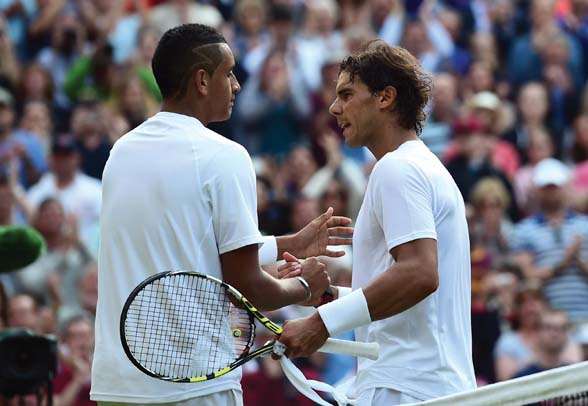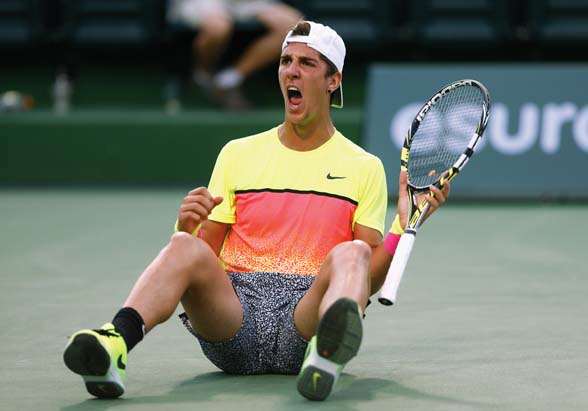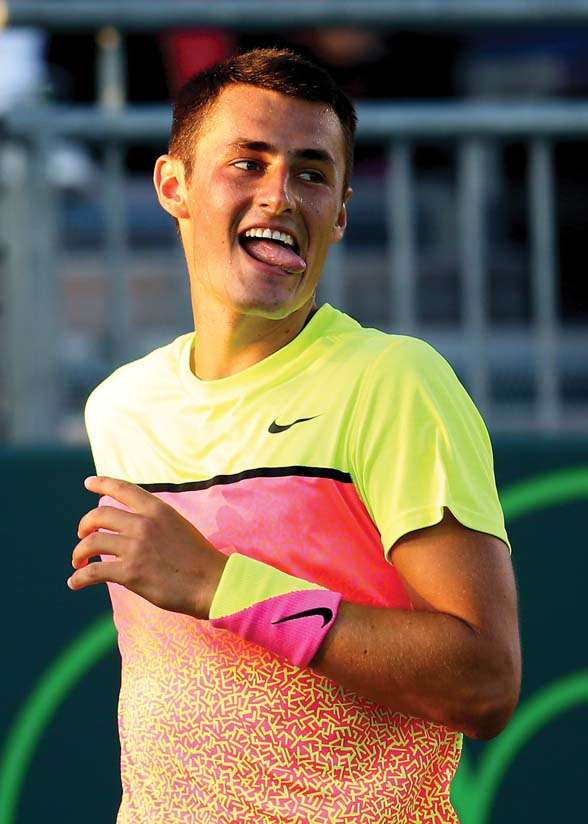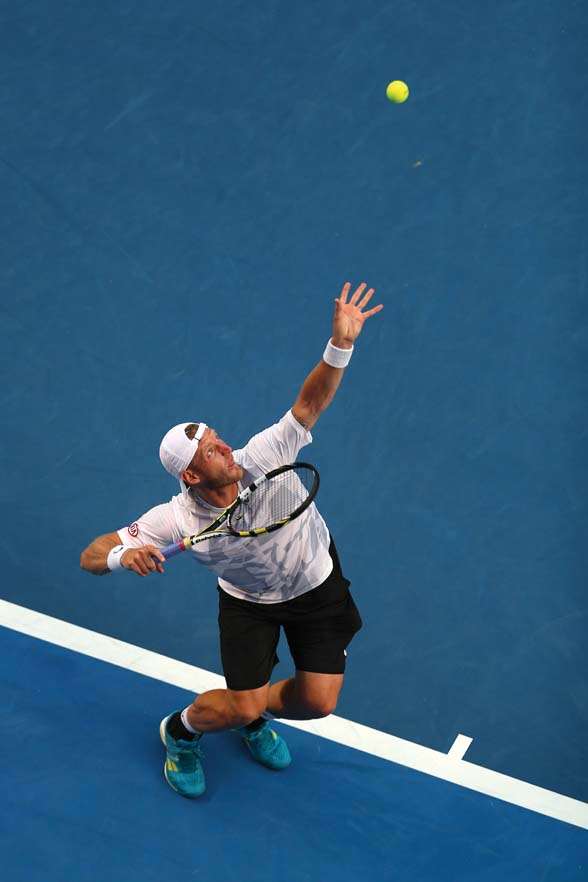Australia once feared who would be the heir to Hewitt's throne.
By Suzi Petkovski
Hard to miss the seismic shift in Australian tennis back at the Australian Open. While battle-weary Lleyton Hewitt trudged into the night after a five-set heartbreaker, the garishly gifted and attired Gen Next - Nick Kyrgios, Thanasi Kokkinakis and Bernard Tomic - served up a future as bright as their fluoro Nike kits.
Kyrgios lit up the Open with charisma and controversy, departing Melbourne Park as the first teenager since Roger Federer to contest two major quarter-finals. Fellow teen Kokkinakis won worldwide raves for his dramatic, 8-6-in-the-fifth upset of Ernests Gulbis, from four match points down. The once-wayward Tomic got himself commando-fit and, a year after he was roundly booed in Rod Laver Arena, equalled his best Australian Open with a run to the fourth round.
It wasn't just the upstarts making waves.
Late bloomer Sam Groth lost to Tomic in the third round, his best major at age 27. Even Marinko Matosevic broke his Aussie Open duck, at the grand old age of 29. But it was the young thrusters - the Special Ks and Tomic - who prompted Hewitt to do what no amount of media pestering, endless injury rehab or tough losses could do: set a retirement date. Days after his crushing loss to journeyman Benjamin Becker, the long-time Aussie flag-bearer and former No.1 announced that the 2016 Australian Open, his 20th home Slam, would be his last.
Immediately, Australian tennis smoothed the path for Hewitt's transition to the Davis Cup captaincy. Pat Rafter stepped down to devote all his energy to the new role of high-performance director, handing the reins to interim captain Wally Masur, coach of Australia's last Davis Cup win in 2003. Hewitt, a de facto vice-captain for the past few years, will take over as captain in 2016.
Hewitt likely always had the 20th Australian Open milestone in mind as a swan song. But the breakout performances of Kyrgios & co. certainly threw a feelgood factor over his post-playing future. The Special Ks, Tomic and Groth are the nucleus of a potent Davis Cup team. "I believe with the guys now, we have a lot more options, a lot more depth," Hewitt noted, allowing him to look ahead to 'a free ride winning Davis Cups' with 'possibly top- ten, top-20' young chargers.
They're not far off. Kyrgios climbed to No.30 in May, after his maiden ATP final in Portugal and his slashing win over Roger Federer, from match points down, in Madrid. Tomic likewise hit a career peak at No.26, retaking the No.1 Aussie ranking he first held as an 18-year-old. Kokkinakis and Groth also enjoyed post-Open ranking highs. Five Aussies were lodged in the top 100 in mid-May, Hewitt not among them.
If the Australian Open was Exhibit A in the generational handover, the Davis Cup win over the Czechs in March was Exhibit B. This was Australia's first victory in the top tier World Group for nine years. Even more significant, Australia advanced without the benefit of a Hewitt win for the first time since 1999. What a luxury - and a positive sign going forward - for a Hewitt win to be surplus to requirements.
In a wintry Ostrava, Tomic won both his singles in straight sets. Kokkinakis, ranked 100 places below top Czech Lukas Rosol, got up from two sets and a break down. It was Gen Next effectively saying, "We got this."
"Everything went our way in Ostrava,î" acknowledges captain Masur. "Bernie won three tiebreaks. Thanasi came back and won after Rosol served for the match. The doubles didn't go our way, but being 2-0 up, losing it didn't really hurt us either." Masur is loath to look ahead to so-called "winnable" ties, such as the looming quarter-final against Kazakhstan on home turf in July. But he is more bullish than his predecessor, the famously keep-a-lid-on-it Rafter.
"Those three guys [Tomic, Kyrgios and Kokkinakis], you can throw a blanket over them," says Masur, a long-time and perceptive commentator for Fox Sports. "All are potential top-20 players, and then the top-ten is a moment away. I'm really positive about all three. Pat [Rafter] was very big on keeping it real. But you can't deny Australian tennis is a good story at the moment."
Even old-school legend Tony Roche is turning up the bombast. "With Lleyton there as the elder statesman, I can see us winning the Davis Cup in two or three years' time, if not this year," said the veteran coach in Ostrava. Coming from the laconic Rochey, them's fighting words!
It isn't just Australians getting excited. Even the top levels of the game are abuzz at how the Aussie young guns will pan out. "Watching the future ... Kokkinakis v Tomic," Andy Murray tweeted of the all-Aussie clash in Brisbane. "I need some popcorn." Back in June last year Muzz gave a shout-out to Kyrgios for winning a lowly Challenger event in Nottingham, tweeting presciently: "We will be seeing a lot of him very shortly on the main tour." And how! In his very next tournament, Kyrgios hit Wimbledon like a meteor, knocking out No.1 Rafael Nadal and turning tennis on its ear.
Even before the Wimbledon heroics, Federer invited Kyrgios and later Kokkinakis to train with him at his base in Dubai. Nadal went out of his way to encourage Kokkinakis after winning their second round at Melbourne Park in 2014. "He will have the chance to be a great player," Nadal said of the 17-year-old, youngest man in the draw. "That's my feeling. He has everything to do it." Big praise for a player ranked No.570.
We've seen false dawns in Australian tennis before. But this is as bright an outlook in the men's game certainly since the late '90s-early 2000s, when we boasted No.1s Rafter and Hewitt, and Mark Philippoussis clinched two Davis Cups from four finals. Many nations would swap places with Australia. Here's why.
He plays in Nick Kyrgios ways
This line, from a ditty sung by the courtside Fanatics (a reworking of U2's Mysterious Ways), pays homage to the rampant Kyrgios X-factor and the audacious shotmaking which one commentator described as "nutty". That would be a compliment rather than a critique.
"Nick is an explosive, big-match player. He feels the moment," notes Masur of his fellow Canberran. "On big points, he wants the ball on his racquet. He wants to make it happen. Nick doesn't hope for the best when a set or match is on the line. You don't want to change that."
Few players have made a greater impact with so few matches. Kyrgios' momentous upset of Nadal at Wimbledon was just his seventh win on the main tour. The 7-6, 5-7, 7-6, 6-3 boilover signalled the generational shift not just in Australian ranks - Kyrgios displacing Hewitt and Tomic as our leading major contender - but a belated teenage assault on the monolithic Big Four. Not since Nadal himself beat Federer in 2005 had a teen toppled the No.1.
Kyrgios' big-match mojo is reflected in his unusual record. Before his run to the final at Estoril in May, he had a grand total of two ATP match wins, versus 15 in Grand Slams and Davis Cup. And already in his budding career, Kyrgios has pulled off a swag of Houdini-like escapes. From nine match points down at Wimbledon against Richard Gasquet (his Estoril conqueror). Match point down against Federer-conqueror Andreas Seppi at Melbourne Park. And two match points down against the maestro himself before prevailing on his sixth match point in Madrid.
The visually arresting showman of Greek-Malaysian parentage feeds off the crowd's energy, turning courtside stands into mosh pits. Kyrgios doesn't so much play a match as perform it. "Game style is predicated on personality," says Masur, who sees no need to curb the exuberance. "Whatever emotion he can bring to the court is good, as long as it's not hurting him."
Indeed, for all the controversy Kyrgios courted at the Open - his hurling of racquets and four-letter words, the snarky reply to a courtside interviewer, the flamboyance that many took for arrogance, the less-than-flattering comparisons with underachieving showmen Gael Monfils and Jo-Wilfried Tsonga - the biggest question mark over his future is the spectre of injury.
Like a former strapping young star in Philippoussis, Kyrgios has already had several long spells out of the game. His breakout 2014 season ended prematurely in September and he came into the Australian Open with just one match in four months. The back stress fracture that he played with in Melbourne (against medical advice) kept him out until mid-March. On his return at Indian Wells, Kyrgios turned his ankle in a slashing match with Grigor Dimitrov and was out for another month. Before Estoril, he'd played just 11 matches for the year. The return to Wimbledon, after his star-making turn in 2014, will be yet another stressful - and insightful - test for #NKRising.
Hello Kokki
Tennis insiders have suggested that Thanasi Kokkinakis could be a better long-term prospect than his mate, Kyrgios. Big call, but not ridiculous. The 18-year-old soared almost 500 rankings places in 2014 and stamped himself a potential major winner with his upset of No.11 seed Ernests Gulbis at Melbourne Park. Of his first seven wins in 2015, five were top-50 scalps.
Like Kyrgios, Kokkinakis is a bristling physical specimen (at 196cm) who has struggled with injury already in his budding career. He lost a combined 13 months to stress fractures in his back in 2012-13. The shared Greek heritage is another point in common with Kyrgios. But their games and personalities are appealingly different. While Kyrgios is a swaggering shotmaker who works the crowd, Kokkinakis is a centred competitor who works the point, though he is not lacking in firepower on the serve and forehand either.
"He's a rock-solid competitor," says Masur of the young South Australian. "From start to finish, he's on his opponent the whole time, like a Nadal or Hewitt. He works and thinks his way through a match. Absorbing disappointment is a big part of tennis and Thanasi does that better than most."
"I think that's one of my big strengths; how I deal with things mentally in matches," said the young giant after a rugged win at Indian Wells in which he ran out of challenges and overcame a howler of a call from the umpire. "I've shown that I can get through a lot of tough, tight ones, even when I'm not playing my best tennis."
In his Davis Cup debut in February 2014, Kokkinakis lost a dead rubber in France. A year on, he impressively won his first live rubber in Ostrava, against No.30 Rosol, to set Australia on its way to a big upset. Rosol served for a straight-sets win at 5-4 in the third. "I pride myself on fighting. I've showed I can do it; I did it at the Australian Open and I did it last year," Kokkinakis said. "I've showed that when my back's against the wall I can usually find a way to get it done. I knew my game would come eventually."
Notching his first win in a major at the 2014 Australian Open, at age 17, Kokkinakis advanced to a valuable schooling from Nadal on Rod Laver Arena. Yet the youngster was undaunted in his 6-2, 6-4, 6-2 loss, holding game points in eight games of the second set.
Months later, Federer invited the youngster to train with him in Dubai. "Roger was working on his game all the time," Kokkinakis said of the takeaway from his week with the maestro. "He was working on specifics non-stop, trying to do little things other players don't do that often just to make them feel uncomfortable. He just told me to keep moving forward with my game. I've got a big game. Just keep being aggressive, come to the net and use it, make it fun."
Hard to believe that Kyrgios and Kokkinakis played off in the Australian junior final two years ago. In this era of older bodies and grinding physicality, they are tracking ahead of the curve. "They are defying that [older] trend a little bit," affirms Masur. "And they are still three or four years from their best tennis. Their games are so good already, but when they get more miles in the legs and more big-match experience, they'll be dangerous."
Kokkinakis begs to differ about his best being a few years off. "I want to do it as quick as I can," says the 19-year-old, one of just three teenagers in the top 100. "I prefer not to make my mark when I'm 27 or 28. There's a lot of older players on the tour. I want to be one of the younger ones pushing through."
Berning Up
We never knew what to make of Bernard Tomic. The guileful Goliath with the domineering dad veered between on- court brilliance - a Wimbledon quarter-final at age 18 - and lurid off-court headlines. "He appeared to be doing his level best," according to veteran American tennis writer Peter Bodo, "to impersonate a horse's derriere."
But we knew one thing: the arrival of the younger Special Ks would be a tonic for Tomic. And so it has proved. No longer is the 22-year-old the new kid on the block, with time on his side.
But credit to Bernie for his response. After a rigorous pre-season he was the most consistent Australian performer over the summer. Even better, Tomic took his hot Aussie form overseas for the first time. A quarter-finalist or better at seven of his first ten events, the 22-year-old set a new ranking PB, defeated young guns Borna Coric and Kokkinakis as well as No.9 David Ferrer en route to the Indian Wells quarters, and took his Davis Cup record to a Hewitt-like 14-2.
"He's got his house in order this year, no doubt about it," says Masur, who spent a week with the teenaged Tomic before taking in the improvement courtside in Ostrava. "His timing and ability is scary. Bernie has a tremendous point of difference in the way he plays. It's motivation and fitness that are key with him. The top 20 beckons and then [he] could be one big win from the top ten."
The Special Ks can't take all the credit for Tomic's resurgence. Double hip surgery early in 2014 - hence his retirement against Nadal in the 2014 Australian Open first round - gave him a serious scare about not taking his career for granted. "I did realise the last year that I have to use these next six, seven years and achieve as much as I can," said the chastened Bernie in March. Tomic dropped to No.124 last July, before salvaging his season with an unlikely title win in Bogota. He was the lowest-ranked and youngest (21) tournament winner of the year. Not for the first time, we saw how quickly the mercurial Tomic can turn his fortunes around.
After defeating Kokkinakis for the second time this year, in the Californian desert resort of Indian Wells, Tomic acknowledged the pressure of playing rising domestic rivals. "Playing someone younger is not easy," he said after his 6-4, 4-6, 6-4 win. "There was a lot of expectation. He was going for it and playing with nothing to lose." But Tomic seems to prefer frenemies around him, over the scrutiny he faced as a lone wolf.
Theirs is a friendly rivalry, according to Masur. "There's no antagonism. Nick, Thanasi and Bernie are friends, they communicate and seem to genuinely get a kick out of each other's results." Aussies are increasingly taking each other out in tournaments - in itself a positive throwback to halcyon days. "That momentum you get when players from the same country push each other and hang out in locker rooms in the latter stages of tournaments is powerful," says Masur. "We Australians, we encourage each other. That's a very good thing," confirms Tomic. "We are driving each other now, everyone is sort of pushing each other and that's the way it should be, in a nation." Echoes of a golden age in Australian tennis.
Grothic Revival
Sam Groth's tennis odyssey is one of the best stories in the game. In 2011, he was all-but lost to tennis, playing suburban football in Melbourne, trying out as a fireman, grappling with both an injured shoulder and the end of his ill-fated marriage to Jarmila Gajdosova.
In 2014, at a tennis middle-aged 26, the rocket-serving net-rusher won his first doubles title, reached his first singles semi-final, cracked the top 100, made a winning Davis Cup debut and won his first match in a major, at the US Open. That earned him a prime-time slot in the game's biggest stadium against the great Federer - not a bad gig for the boy who grew up on the Murray.
"Friday night in New York, packed stadium, playing Roger," recalls the personable Aussie, whose relaxed off-court demeanour is in stark contrast to his mean game-face. "At 6-4, 6-4, 5-4 I looked around and took it all in, thinking how far I'd come."
Far from satisfied with his breakout year, Groth came out swinging in 2015, welcoming defending champion Hewitt back to Brisbane with a 6-2, 6-3 trouncing. At Melbourne Park, he put out Kokkinakis 6-1 in the fifth for his deepest run at a major, and was miffed at the courtside interviewer labelling him "the underdog". Groth was ranked No.81 to the wildcard's No.147.
It recalled the lack of official recognition that greeted Groth after he struck the fastest-ever serve (263km/h) at a Challenger event in South Korea in May 2012. Although the feat put him back on the tennis radar ('scuse the pun), the ATP didn't immediately acknowledge the Aussie as the world's fastest server. Reasons? The record wasn't set on the main tour; a faulty reading was suspected (partly because Groth hadn't achieved anything of note); and there was talk of standardised equipment. "Then they found out it was the same equipment that's used at Wimbledon," Groth wryly notes.
Riding a ranking high of No.68 in May, Groth is in little doubt he belongs in the top echelon, though he tailed off after Australia, as he suspected. "Guys are not going to like seeing my name in the draw next to theirs," he declared early in the year. "They're going to figure me out a bit, too."
Like the similarly big-serving and late-blooming Wayne Arthurs, Groth gives the Davis Cup team more versatility. He played both doubles [with Hewitt] and the dead fifth rubber in the Czech Republic. "I think I have a lot of good years ahead of me," says the No.3 Aussie. "I'm looking forward to my first full year playing singles and doubles as a main-draw player. It's all ahead of me. And it's great to be part of a big Aussie presence."
Yep, exciting times for Australian tennis. Even more so with a transitional era opening up. Roger and Rafa are in their sunset years. New champions emerge swiftly. "I'm constantly amazed at the renewal in the game," says Masur, who began his career in the Bjorn Borg era and achieved his highest mark of No.15 in the Pete Sampras-Andre Agassi days. "I look forward to the next phase. Roger is well into his 30s and Rafa is paying the price for a brutal game style. I don't want to get crazy, but if I was one of the young Australians, I'd be pushing for Grand Slams and I'd do anything I can to get one. Pat Rafter won't like this but I'd be thinking: 'I can threaten here; I can win a major.'
Related Articles

Feature Story: Moving the Needle

The Aussies at The Open


